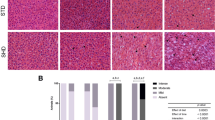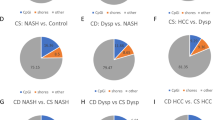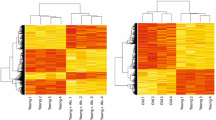Abstract
Altered expressions of lysophosphatidic acid (LPA) receptor genes have been reported in tumor cells of human and rats. Recently, we detected the frequent mutations of LPA receptor-1 (LPA1) gene in rat hepatocellular carcinomas (HCCs) induced by a choline-deficient l-amino acid-defined (CDAA) diet. In this study, the DNA methylation patterns of LPA receptor genes and their expression levels during rat hepatocarcinogenesis induced by the CDAA diet were investigated. Six-week-old F344 male rats were continuously fed with the CDAA diet, and animals were then killed at 7 days and 2, 12, 20, and 75 weeks, respectively. Genomic DNAs were extracted from livers and HCCs for the assessment of methylation status by bisulfite sequencing, comparing to normal livers. The livers of rats fed the CDAA diet were unmethylated in LPA1 and LPA2 genes as well as normal livers. In LPA3 gene, although normal livers were unmethylated, the livers at 7 days and 2 and 12 weeks weakly or moderately methylated and those at 20 weeks markedly methylated. Moreover, 4 HCCs were completely methylated in LPA3 gene. Expression levels of LPA receptor genes in the livers of rats fed the CDAA diet and HCCs were correlating with DNA methylation status. These results indicate that DNA methylation status of the LPA3 gene was disturbed in the livers of rats fed the CDAA diet and established HCCs, suggesting that alterations of the LPA receptor genes might be involved during rat hepatocarcinogenesis induced by the CDAA diet.





Similar content being viewed by others
References
An S, Bleu T, Halmark OG, Goetzl EJ (1998) Characterization of a novel subtype of human G protein-coupled receptor for lysophosphatidic acid. J Biol Chem 273:7906–7910
Bandoh K, Aoki J, Hosono H, Kobayashi S, Kobayashi T, Murakami-Murofushi K, Tsujimoto M, Arai H, Inoue K (1999) Molecular cloning and characterization of a novel human G-protein-coupled receptor, EDG7, for lysophosphatidic acid. J Biol Chem 274:27776–27785
Christman JK (1995) Lipotrope deficiency and persistent changes in DNA methylation: lipotrope deficiency and DNA methylation. Adv Exp Med Biol 375:97–106
Christman JK, Sheiknejad G, Dizik M, Abileah S, Wainfan E (1993) Reversibility of changes in nucleic acid methylation and gene expression induced in rat liver by severe methyl deficiency. Carcinogenesis 14:551–557
Contos JJA, Ishii I, Chun J (2000a) Lysophosphatidic acid receptors. Mol Pharmacol 58:1188–1196
Contos JJA, Fukushima N, Weiner JA, Kaushal D, Chun J (2000b) Requirement for the lpA1 lysophosphatidic acid receptor gene in normal suckling behavior. Proc Natl Acad Sci USA 97:13383–13389
Contos JJA, Ishii I, Fukushima N, Kingsbury MA, Ye X, Kawamura S, Brown JH, Chun J (2002) Characterization of lpa(2) (Edg4) and lpa(1)/lpa(2) (Edg2/Edg4) lysophosphatidic acid receptor knockout mice: signaling deficits without obvious phenotypic abnormality attributable to lpa(2). Mol Cell Bio 22:6921–6929
Fang X, Schummer M, Mao M, Yu S, Tabassam FH, Swaby R, Hasegawa Y, Tanyi JL, LaPushin R, Eder A, Jaffe R, Erickson J, Mills GB (2002) Lysophosphatidic acid is a bioactive mediator in ovarian cancer. Biochim Biophys Acta 1582:257–264
Fujita T, Miyamoto S, Onoyama I, Sonoda K, Mekada E, Nakano H (2003) Expression of lysophosphatidic acid receptors and vascular endothelial growth factor mediating lysophosphatidic acid in the development of human ovarian cancer. Cancer Lett 192:161–169
Furui T, LaPushin R, Mao M, Khan H, Watt SR, Watt MAV (1999) Overexpression of Edg-2/vzg-1 Induces apoptosis and anoikis in ovarian cancer cells in a lysophosphatidic acid-independent manner. Clini Cancer Res 5:4308–4318
Giambarresi LI, Katyal SL, Lombardi B (1982) Promotion of liver carcinogenesis in the rat by a choline-devoid diet. Role of liver cell necrosis and regeneration. Br J Cancer 46:825–829
Goetzl EJ, Dolezalova H, Kong Y, Hu YL, Jaffe RB, Kalli KR, Conover CA (1999) Distinctive expression and functions of the type 4 endothelial differentiation gene-encoded G protein-coupled receptor for lysophosphatidic acid in ovarian cancer. Cancer Res 59:5370–5375
James SJ, Pogribny IP, Pogribna M, Miller BJ, Jemigan S, Melnyk S (2003) Mechanisms of DNA damage, DNA hypomethylation, and tumor progression in the folate/methyl-deficient rat model of hepatocarcinogenesis. J Nutr 133:3740S–3747S
Laird PW, Jaenisch R (1994) DNA methylation and cancer. Hum Mol Genet 3:1487–1495
Lee CW, Rivera R, Gardell S, Dubin AE, Chun J (2006) GPR92 as a new G12/13 and Gq coupled lysophosphatidic acid receptor that increases cAMP: LPA5. J Biol Chem 281:23589–23597
Lin M-E, Herr DR, Chun J (2010) Lysophosphatidic acid (LPA) receptors: signaling properties and disease relevance. Prostaglandins Other Lipid Mediat 91:130–138
Locker J, Reddy TV, Lombardi B (1986) DNA methylation and hepatocarcinogenesis in rats fed a choline-devoid diet. Carcinogenesis 8:1309–1312
Lombardi B (1988) The choline-devoid diet model of hepatocarcinogenesis in rats. In: Feo F, Pani P, Columbano A, Grecea R (eds) Chemical carcinogenesis. Plenum Press, New York, pp 569–581
Nakae D, Yoshiji H, Maruyama H, Kinugasa T, Denda A, Konishi Y (1990) Production of both 8-hydroxydeoxyguanosine in liver DNA and γ-glutamyltransferase-positive hepatocellular lesions in rats given a choline-deficient, l-amino acid-defined diet. Jpn J Cancer Res 81:1081–1084
Nakae D, Yoshiji H, Mizumoto Y, Horiguchi K, Shiraiwa K, Tamura K, Denda A, Konishi Y (1992) High incidence of hepatocellular carcinomas induced by a choline deficient l-amino acid defined diet in rats. Cancer Res 52:5042–5045
Noguchi K, Ishii S, Shimizu T (2003) Identification of p2y9/GPR23 as a novel G protein-coupled receptor for lysophosphatidic acid, structurally distant from the Edg family. J Biol Chem 278:25600–25606
Obo Y, Yamada T, Furukawa M, Hotta M, Honoki K, Fukushima N, Tsujiuchi T (2009) Frequent mutations of lysophosphatidic acid receptor-1 gene in rat liver tumors. Mutat Res 660:47–50
Pasternack SM, von Kügelgen I, Aboud KAJ, Lee Y-A, Rüschendorf F, Voss K, AHillmer AM, Molderings GJ, Franz T, Ramirez A, Nürnberg P, Nöthen MM, Berz RC (2008) G protein-coupled receptor P2Y5 and its ligand LPA are involved in maintenance of human hair growth. Nat Genet 40:329–334
Perera MIR, Demetris AJ, Katyal SL, Shinozuka H (1985) Lipid peroxidation of liver microsome membranes induced by choline-deficient diets and its relationship to the diet-induced promotion of the induction of gamma-glutamyltranspeptidase-positive foci. Cancer Res 5:2533–2538
Poirier LA (1994) Methyl group deficiency in hepatocarcinogenesis. Drug Metab Rev 26:185–199
Rushmore TH, Farber E, Ghoshal AK, Parodi S, Pala M, Taningher M (1986) A choline-devoid diet, carcinogenic in the rat, induces DNA damage and repair. Carcinogenesis 7:1677–1680
Schulte KM, Beyer A, Kohrer K, Oberhauser S, Roher HD (2001) Lysophosphatidic acid, a novel lipid growth factor for human thyroid cells: over-expression of the high-affinity receptor edg4 in differentiated thyroid cancer. Int J Cancer 92:249–256
Shida D, Kitayama J, Yanaguchi H, Okaji Y, Tsuno NH, Watanabe T, Takuwa Y, Nagawa H (2003) Lysophosphatidic acid (LPA) enhances the metastatic potential of human colon carcinoma DLD1 cells through LPA1. Cancer Res 63:1706–1711
Shida D, Watanabe T, Aoki J, Hama K, Kitayama J, Sonoda H, Kishi Y, Yamaguchi H, Sasaki S, Sako A, Konishi T, Arai H, Nagawa H (2004) Aberrant expression of lysophosphatidic acid (LPA) receptors in human colorectal cancer. Lab Investig 84:1352–1362
Shimizu K, Onishi M, Sugata E, Sokuza Y, Mori C, Nishikawa T, Honoki K, Tsujiuchi T (2007) Disturbance of DNA methylation patterns in the early phase of hepatocarcinogenesis induced by a choline-deficient l-amino acid-defined diet in rats. Cancer Sci 98:1318–1322
Shimomura Y, Wajid M, Ishii Y, Shapiro L, Petukhowa L, Gordon D, Christiano AM (2008) Disruption of P2Y5, an orphan G protein-coupled receptor, underlies autosomal recessive woolly hair. Nat Genet 40:335–339
Shinozuka H, Katyal SL, Perera MIR (1986) Choline deficiency and chemical carcinogenesis. In: Poirier LA, Newberne PM, Pariza MW (eds) Essential nutrients in carcinogenesis. Plenum Press, New York, pp 253–267
Tsujino M, Fujii M, Okabe K, Mori T, Fukushima N, Tsujiuchi T (2010) Differential expressions and DNA methylation patterns of lysophosphatidic acid receptor genes in human colon cancer Cells. Virchows Arch 457:669–676
Tsujiuchi T, Tsutsumi M, Sasaki Y, Takahama M, Konishi Y (1999) Hypomethylation of CpG sites and c-myc gene overexpression in hepatocellular carcinomas, but not hyperplastic nodules, induced by a choline-deficient l-amino acid-defined diet in rats. Jpn J Cancer Res 90:909–1013
Tsujiuchi T, Shimizu K, Itsuzaki Y, Onishi M, Sugata E, Fujii H, Honoki K (2006a) CpG site hypermethylation of E-cadherin and Connexin26 genes in hepatocellular carcinomas induced by a choline-deficient l-amino acid-defined diet in rats. Mol Carcinog 46:269–274
Tsujiuchi T, Shimizu K, Onishi M, Sugata E, Fujii H, Mori T, Honoki K, Fukushima N (2006b) Involvement of aberrant DNA methylation on reduced expression of lysophosphatidic acid receptor-1 gene in rat tumor cell lines. Biochem Biophys Res Commun 349:1151–1155
Weitzman SA, Turk PW, Milkowski DH, Kozlowski K (1994) Free radical adducts induce alterations in DNA cytosine methylation. Proc Natl Acad Sci USA 91:1261–1264
Acknowledgments
This study was supported in part by the Foundation for Promotion of Cancer Research in Japan, a Grant-in-Aid (20591765) for Scientific Research from Ministry of Education, Culture, Sports, Science and Technology of Japan, Grants (21321201) from the Ministry of Health, Labor and Welfare of Japan, and grants (RK-027) from the Faculty of Science and Engineering, Kinki University.
Conflict of interest
The authors declare that they have no conflict of interest.
Author information
Authors and Affiliations
Corresponding author
Rights and permissions
About this article
Cite this article
Okabe, K., Hayashi, M., Yoshida, I. et al. Distinct DNA methylation patterns of lysophosphatidic acid receptor genes during rat hepatocarcinogenesis induced by a choline-deficient l-amino acid-defined diet. Arch Toxicol 85, 1303–1310 (2011). https://doi.org/10.1007/s00204-011-0656-7
Received:
Accepted:
Published:
Issue Date:
DOI: https://doi.org/10.1007/s00204-011-0656-7




